
B'nai Abraham Synagogue is a former synagogue in Virginia, Minnesota, United States. It was constructed in 1909 as the first purpose-built synagogue on the Iron Range. It served as the heart of the local Jewish community in the early 20th century. The building was listed on the National Register of Historic Places in 1980 for its local significance in the themes of religion and social history. It was nominated for attesting both to the ethnic diversity of the Iron Range and to the commonality of its immigrant groups maintaining cohesion around religious centers.
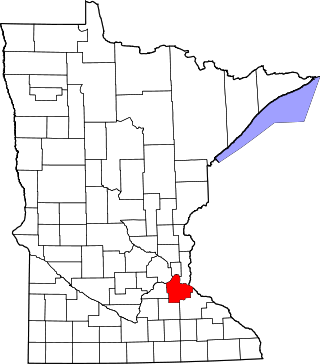
This is a list of the National Register of Historic Places listings in Dakota County, Minnesota. It is intended to be a complete list of the properties and districts on the National Register of Historic Places in Dakota County, Minnesota, United States. Dakota County is located in the southeastern part of the U.S. state of Minnesota, bounded on the northeast side by the Upper Mississippi River and on the northwest by the Minnesota River. The locations of National Register properties and districts for which the latitude and longitude coordinates are included below, may be seen in an online map.
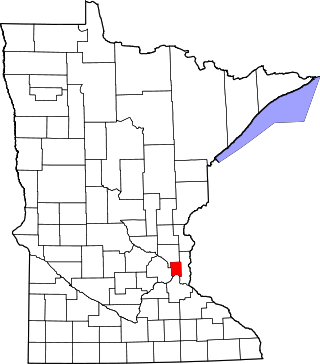
This is a complete list of National Register of Historic Places listings in Ramsey County, Minnesota. It is intended to be a complete list of the properties and districts on the National Register of Historic Places in Ramsey County, Minnesota, United States. The locations of National Register properties and districts for which the latitude and longitude coordinates are included below, may be seen in an online map.

This is a list of the National Register of Historic Places listings in Saint Louis County, Minnesota. It is intended to be a complete list of the properties and districts on the National Register of Historic Places in Saint Louis County, Minnesota, United States. The locations of National Register properties and districts for which the latitude and longitude coordinates are included below, may be seen in an online map.

There are 75 properties listed on the National Register of Historic Places in Albany, New York, United States. Six are additionally designated as National Historic Landmarks (NHLs), the most of any city in the state after New York City. Another 14 are historic districts, for which 20 of the listings are also contributing properties. Two properties, both buildings, that had been listed in the past but have since been demolished have been delisted; one building that is also no longer extant remains listed.

The PAD Factory is a historic factory building located at Ticonderoga in Essex County, New York. It was built in 1893 and is a 3-story, five-by-three-bay brick industrial building with a fieldstone foundation and a low pitched gable roof. It was originally built for the manufacture of blank books, but was used almost immediately for a variety of purposes including a temporary school and shirt factory. It was converted for residential and commercial uses in 1981.
Esenwein & Johnnson was an architectural firm of Buffalo, New York.

The Church of St. John the Baptist was a historic church building in Virginia, Minnesota, United States. It was built in 1924 by a Polish American congregation of Roman Catholics. In 1980 the church was listed on the National Register of Historic Places under the name Church of St. John the Baptist (Catholic) for its local significance in the themes of religion and social history. It was nominated for serving as the center of religious and social life for Virginia's Polish Americans.

The Church of St. Michael is a historic Roman Catholic church building in St. Michael, Minnesota, United States, constructed in 1890. It was listed on the National Register of Historic Places in 1979 for having local significance in the themes of architecture, exploration/settlement, and religion. It was nominated for its status as the dominant architectural feature and the religious and social center of a German Catholic community.
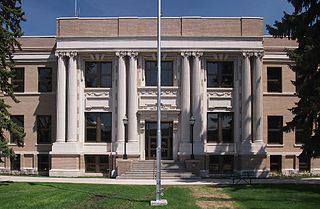
The St. Louis County District Courthouse is the seat of government for the northern district of St. Louis County, Minnesota, United States, located in the city of Virginia. The St. Louis County District Court is held in three locations: Duluth, Hibbing and Virginia.

The YWCA of Duluth is a former YWCA building in Duluth, Minnesota, United States. It was designed by architects Frederick German and Anton Werner Lignell and built in 1908 to provide programs and activities for Duluth's young, single women. It contained a gymnasium, swimming pool, cafeteria, meeting rooms, and apartments. In addition to the organization's usual suite of athletics, Bible study, and employment assistance, the YWCA of Duluth catered to the city's large foreign-born population with English and citizenship classes. The building was listed on the National Register of Historic Places in 2011 for its local significance in the theme of social history. It was nominated for its role in local civic development through the YWCA's social welfare efforts.

The Virginia–Rainy Lake Lumber Company Office is a former office building in Virginia, Minnesota, United States. It was built around 1907 as the headquarters for the Virginia–Rainy Lake Lumber Company, the largest lumber company in the Upper Midwest in the early 20th century. The building was listed on the National Register of Historic Places in 1980 for its state-level significance in the theme of industry. It was nominated for representing one of the Iron Range's few major industries aside from mining.

The Virginia–Rainy Lake Lumber Company Manager's Residence is a historic house in Virginia, Minnesota, United States. It was built in 1910 to provide upscale quarters for the manager of the Virginia–Rainy Lake Lumber Company, the largest lumber company in the area. The house was listed on the National Register of Historic Places in 1980 for its local significance in the themes of industry and social history. It was nominated for reflecting the social distance enforced between industry elites and laborers in the early 20th century. The city's working class population at the time was crowded into boarding houses and small cottages, and it was common for large companies to erect lavish residences for their managerial class in the belief that telegraphing class distinctions was essential for maintaining workforce discipline.

Virginia City Hall is the seat of government for Virginia, Minnesota, United States. It was designed by architect Frederick German and built from 1923 to 1924. It continues to house municipal offices, the Virginia Police Department, and a public meeting hall. Virginia City Hall was listed on the National Register of Historic Places in 2004 for its local significance in the theme of politics/government. It was nominated for being the long-serving seat of Virginia's municipal government.
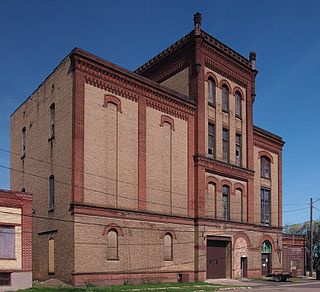
The Virginia Brewery is a former brewery in Virginia, Minnesota, United States. It was built in 1905 and closed during Prohibition. The building was listed on the National Register of Historic Places in 1980 for its local significance in the themes of architecture, commerce, and industry. It was nominated for being a distinctive example of the local breweries that contributed to economic and social life of the Iron Range before Prohibition and competition from larger brands put them out of business.

Kaleva Hall is a historic Finnish-American clubhouse in Virginia, Minnesota, United States. It was operated by the Valon Tuote temperance society from its construction around 1906 until the late 1960s, after which it was acquired by the Knights and Ladies of Kaleva. The building was listed on the National Register of Historic Places in 1980 under its Finnish name Valon Tuote Raittiusseura for its local significance in the themes of education, entertainment/recreation, and social history. It was nominated for continuously serving as the headquarters of one of the city's major ethnic groups throughout the 20th century.
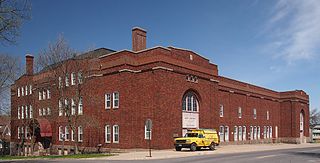
The Eveleth Recreation Building, later the Arrow Shirt Factory, is a historic building in Eveleth, Minnesota, United States. It was constructed in 1918 as a municipal gymnasium, with a curling rink on the ground floor and an ice hockey rink on the second floor. At that time the city of Eveleth was flush with tax revenue from the Mesabi Range mining boom, and the population was heavily male from the influx of mine workers. As the gender balance evened out in the 1930s, the building was converted into a garment factory, answering a need for employment opportunities for women and diversifying the local economy.
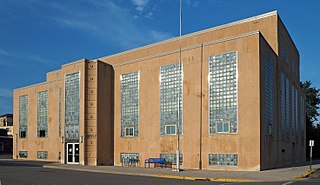
The Ely Community Center is a historic municipal building in Ely, Minnesota, United States. It was built in 1938 with funding assistance from the Public Works Administration, one of many New Deal projects designed to provide both short-term employment and lasting benefits to a community. The Ely Community Center initially housed the public library, an auditorium, meeting rooms, and offices, as well as a cafeteria and public showers. The building's design mixed Art Deco with restrained Neoclassical formalism, a style that came to be known as PWA Moderne.

The Coates House is a historic house in Virginia, Minnesota, United States. It was built around 1912 as one of the city's larger and finer residences. A succession of prominent people in the local lumber industry lived in it. The house was listed on the National Register of Historic Places in 1980 for its local significance in the themes of architecture and social history. It was nominated for demonstrating the class distinctions telegraphed by housing stock on the Iron Range at the turn of the 20th century. Large houses for the managerial class provided a sharp contrast to the boarding houses and small cottages into which the period's working class population was crowded.





















